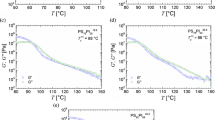Summary
From the break-down in the viscosity of a polymer solution, associated with the entrance into the two phase region, the pressure dependence of the demixing temperatures of solutions of polystyrene (M = 600.000) in cyclohexane, cyclopentane, diethylmalonate and 1-phenyldecane was measured up to 1000 bar. The application of pressure increases the solubility of polystyrene in cyclopentane and diethylmalonate, but decreases that in 1-phenyldecane; in the case of cyclohexane, a pressure of optimum miscibility is observed at ca. 120 bar.
The discussion of these findings, together with further information from the literature, demonstrates that current theories cannot even predict the pressure influences qualitatively. For an easy forecast of the effects, the distance of the (upper) critical solution temperature,T c from the melting point of the solvent,T MP, can, however, serve as a guideline: From the present material it can be concluded thatT c is increased by pressure if (T —T MP)/T MP (K/K) is less than 0,20 but decreased it if it exceeds 0,25.
Zusammenfassung
Aus dem Viskositätszusammenbruch von Polymerlösungen, der mit dem Eintritt ins Zweiphasengebiet einhergeht, wurde die Druckabhängigkeit der Entmischungstemperaturen für Lösungen von Polystyrol (M = 600.000) in Cyclohexan, Cyclopentan, Diethylmalonat und 1-Phenyldekan bis 1000 bar bestimmt. Die Anwendung von Druck erhöht die Löslichkeit von Polystyrol in Cyclopentan und Diethylmalonat, erniedrigt aber die in 1-Phenyldekan; im Falle von Cyclohexan wird bei ca. 120 bar ein Druck optimaler Mischbarkeit beobachtet.
Die Diskussion dieser Ergebnisse, zusammen mit Literaturangaben, zeigt, daß die Druckeinflüsse durch die gängigen Theorien nicht einmal qualitativ vorhergesagt werden können. Für eine einfache Abschätzung der Effekte kann jedoch der Abstand der (oberen) kritischen Entmischungstemperatur,T c, vom Schmelzpunkt des Lösungsmittels,T MP, herangezogen werden: Aus dem vorliegenden Material folgt, daßT c mit dem Druck steigt, wenn (T c —T MP)/T MP (K/K) kleiner ist als 0,20 und fällt, wenn ein Wert von 0,25 überschritten wird.
Similar content being viewed by others
Literature
Geerissen, H., J. R. Schmidt, B. A. Wolf, J. Appl. Pol. Sci. in press.
Wolf, B. A., M. C. Sezen, Macromolecules10, 1010 (1977).
Wolf, B. A., R. Jend, Macromolecules12, 732 (1979).
Schmidt J. R. B. A. Wolf, Coll. Polymer Sci.257, 1188 (1979).
Wolf, B. A., Makromol. Chem. Rapid Commun.1, 231 (1980).
Wolf, B. A., G. Blaum, Makromol. Chem.177, 1073 (1976).
Saeki, S., N. Kuwahara, M. Nakata, M. Kaneko, Polymer16, 445 (1975).
Ishizawa, M., S. Saeki, N. Kuwahara, M. Nakata, M. Kaneko, W. Nagayama, Macromolecules11, 871 (1978).
Rehage, G., Z. Naturforsch.10a, 300 (1955).
Schotsch, K., Diplomarbeit (Mainz 1978).
Patterson, D., G. Delmas, Trans. Faraday Soc.65, 708 (1969).
Biros, J., L. Zeman, D. Patterson, Macromolecules4, 30 (1971).
Hildebrand, J. H., R. L. Scott, “Solubility of Nonelectrolytes” Reinhold, New York (N.Y. 1950).
Author information
Authors and Affiliations
Additional information
Dedicated to Prof. Dr. K. Ueberreiter in honor of his 70th birthday.
Rights and permissions
About this article
Cite this article
Wolf, B.A., Geerissen, H. Pressure dependence of the demixing of polymer solutions determined by viscometry. Colloid & Polymer Sci 259, 1214–1220 (1981). https://doi.org/10.1007/BF01525017
Received:
Issue Date:
DOI: https://doi.org/10.1007/BF01525017



